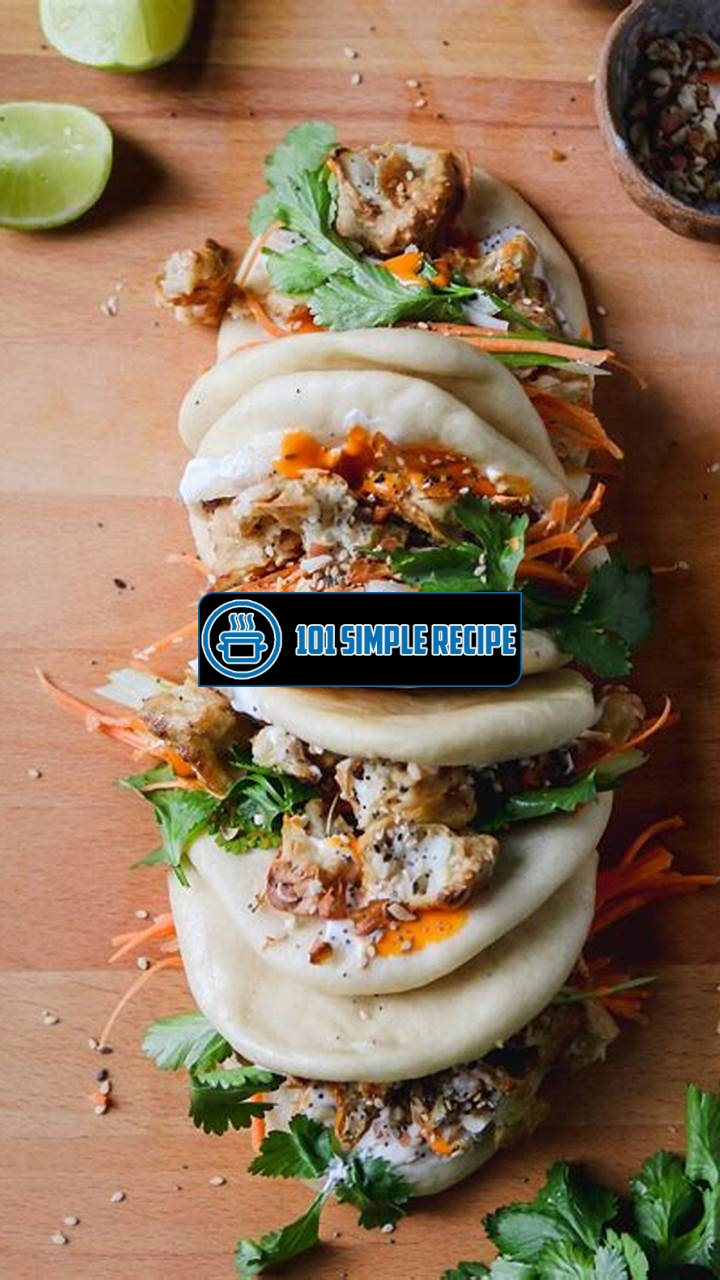If you’ve ever been to a dim sum restaurant, there’s no doubt you’ve indulged in the delightful steamed bao buns. These pillowy-soft, fluffy buns are filled with a variety of scrumptious fillings, making them a beloved favorite among food lovers. But have you ever wondered how to make these delectable treats in the comfort of your own kitchen? Well, wonder no more! In this article, we will guide you through the art of steaming bao buns, so you can recreate this mouthwatering dish in your own home. Get ready to embark on a culinary adventure as we uncover the secrets to mastering the art of steaming bao buns.

Choosing the Right Bao Bun
When it comes to mastering the art of steaming bao buns, one of the most crucial steps is selecting the right type of bun. There are various options available, each with its own unique characteristics. From traditional bao buns to store-bought alternatives, understanding the differences and choosing the perfect bun is key to achieving the delicate and fluffy texture that bao buns are known for.
Understanding Traditional vs. Store-Bought Bao Buns
Traditionally, bao buns are handmade from scratch using a specific dough recipe. These homemade buns are often softer and more delicate compared to their store-bought counterparts. The process of making traditional bao buns involves a combination of yeast, flour, sugar, and water. The dough is then left to rise, resulting in a light and airy texture.
On the other hand, store-bought bao buns are a convenient option for those who lack the time or skills to make them from scratch. These buns are typically pre-made and can be found in the frozen or refrigerated section of grocery stores. Store-bought bao buns often have a slightly denser texture compared to traditional buns, but they can still yield delicious results when properly steamed.
Criteria for Choosing Bao Buns
When selecting bao buns for steaming, there are a few criteria to consider:
- Texture: Look for buns with a soft and fluffy texture. This will ensure a light and airy bao bun after steaming.
- Freshness: Check the expiration date or packaging to ensure the buns are fresh. Stale buns can result in a dry and less enjoyable eating experience.
- Size: Consider the size of the buns and whether they will fit comfortably in your steamer. Oversized buns may not steam evenly.
- Ingredients: Read the ingredients list to ensure the buns contain high-quality, recognizable ingredients. Avoid buns with preservatives or artificial additives.
By keeping these criteria in mind, you can select bao buns that are perfect for steaming and producing delicious results.
Recommended Brands for Store-Bought Bao Buns
While homemade bao buns are often the preferred choice for their superior texture, there are some excellent store-bought alternatives available. Here are a few recommended brands:
- ABC Bao Bun Co.: Known for their authentic taste and fluffy texture, ABC Bao Bun Co. offers a range of frozen buns that are quick and easy to steam.
- Delightful Buns: Delightful Buns is a popular brand that specializes in ready-to-steam bao buns. They offer a variety of flavors and have a consistently soft and tasty bun.
- Steamed Delights: Steamed Delights is another trusted brand that offers pre-made bao buns. Their buns are known for their light texture and delicious fillings.
These recommended brands have been praised by bao bun enthusiasts for their quality and taste. It’s always a good idea to try different brands and find the one that best suits your preferences.
With the right bao bun and a little practice, you’ll soon master the art of steaming these delightful Chinese treats!
Preparing the Bao Buns
When it comes to steaming bao buns, preparation is key. You want to ensure that your bao buns are thawed, dough is properly rested, and they are shaped correctly before steaming. In this section, we will guide you through each step to help you master the art of steaming bao buns.
Thawing Frozen Bao Buns
If you have frozen bao buns, it’s important to thaw them properly before steaming. Thawing frozen bao buns is a simple process that requires a little bit of patience. Here’s how you can do it:
- Remove the frozen bao buns from the freezer and place them in a covered container or a resealable plastic bag.
- Leave them to thaw at room temperature for about 1 to 2 hours. The exact time may vary depending on the size and thickness of the bao buns, so keep an eye on them.
- Once the bao buns are completely thawed, gently separate them to prevent them from sticking together.
Note: Avoid using a microwave to thaw the bao buns, as it can make them tough and dry.
Resting Dough for Homemade Bao Buns
If you prefer making homemade bao buns from scratch, it’s crucial to give the dough enough time to rest. Resting the dough allows the gluten to relax and the yeast to develop flavor, resulting in soft and fluffy bao buns. Here’s what you need to do:
- After kneading the dough, cover it with a clean kitchen towel or plastic wrap and let it rest at room temperature for at least 1 hour. This resting period will allow the dough to rise and become more pliable.
- After the initial resting period, punch down the dough to release any air bubbles. Then, divide the dough into small equal portions, which will be shaped into individual bao buns.
- Cover the divided dough portions again and let them rest for an additional 30 minutes. This secondary resting period helps the bao buns to rise and become even softer when steamed.
Note: Don’t rush the dough resting process, as it is essential for achieving the best texture and flavor in your bao buns.
Shaping Bao Buns
Shaping bao buns is an important step that affects both their appearance and texture. Properly shaped bao buns will have a pleasing round shape and a fluffy interior. Follow these steps to shape your bao buns:
- Take a portion of the rested dough and flatten it with the palm of your hand to create a small round disc.
- Using your fingertips, pleat and fold the edges of the disc towards the center while rotating it. This will create a pleated closure on top.
- Pinch the pleated closure tightly to seal the bao bun.
- Place the shaped bao bun on a small parchment paper square or cupcake liner to prevent sticking.
- Repeat the process for the remaining dough portions, ensuring that the bao buns are evenly shaped and sealed.
Master the Art of Steaming Bao Buns by following these essential steps in preparing your bao buns. Thawing frozen bao buns, resting the dough, and shaping the bao buns will guarantee a delicious and authentic steamed bun experience. So, get ready to enjoy these fluffy delights filled with your favorite savory or sweet fillings!
The Art of Steaming Food: Techniques and Tips
Steaming Tools and Equipment
When it comes to steaming bao buns to perfection, having the right tools and equipment is essential. The following are some of the key items you’ll need for successful bao bun steaming, along with their specific functions:
- Steamer: The steamer is the main tool you’ll need for steaming bao buns. It consists of a base pot or pan and a lid with steam holes. The steamer creates the perfect environment for steaming, allowing the buns to cook evenly and retain their moisture.
- Water container: To generate steam, you’ll need a container to hold the water. This can be a separate pot or a built-in reservoir in your steamer. Make sure to replenish the water as needed during the steaming process to prevent it from running dry.
- Heat source: To steam your bao buns, you’ll need a heat source. This can be a stovetop burner or an electric steamer. Choose the heat source that works best for you and ensure that it provides a consistent and even heat distribution.
Steamer Types and Options
There are various types and options available when it comes to steamers. Here are a few popular choices:
- Bamboo steamer: Bamboo steamers are a traditional option for steaming bao buns. They are made of bamboo and come in different sizes. These steamers create a natural and gentle steam environment, allowing the buns to cook slowly and retain their soft texture.
- Metal steamer: Metal steamers are another common choice. They are usually made of stainless steel and come with multiple layers or compartments, allowing you to steam multiple batches of buns at once. Metal steamers are durable and easy to clean.
- Electric steamer: If convenience is your priority, an electric steamer may be the right choice for you. These steamers have built-in water reservoirs and heating elements, eliminating the need for a separate heat source. Electric steamers often come with additional features, such as timers and temperature control.
Choosing the Right Steaming Basket or Tray
When selecting a steaming basket or tray, consider the following factors:
- Size: Choose a basket or tray that can accommodate the number of buns you plan to steam at once. It should have enough space for the buns to expand while cooking without touching each other.
- Material: Steaming baskets and trays are typically made of bamboo or metal. Consider the advantages and disadvantages of each material. Bamboo provides a gentle steam environment, while metal is more durable and easier to clean.
- Design: Some baskets or trays come with built-in handles or legs, making it easier to lift and move them. Consider the design features that will make your steaming process more convenient and efficient.
Using Alternative Steaming Techniques
In addition to traditional steaming methods, there are alternative techniques you can explore:
- Instant Pot steaming: If you own an Instant Pot, you can use its steam function to steam bao buns. Simply place the buns on a steaming rack, add water to the pot, and set it to the desired cooking time. This method offers convenience and precise temperature control.
- Microwave steaming: In a pinch, you can also steam bao buns using a microwave. Wrap the buns in a damp paper towel and microwave them for a short period, checking for doneness as you go. This method is quick but may not yield the same soft and fluffy texture as traditional steaming.
By mastering the art of steaming bao buns, you can enjoy these delicious treats with the perfect texture and taste. Ensure you have the right tools and equipment, explore different steamer types and options, choose the appropriate steaming basket or tray, and consider alternative steaming techniques for added convenience. Happy steaming!
Proper Steaming Techniques
Steaming bao buns is a delicate process that requires precision and attention to detail. By mastering the art of steaming, you can achieve the perfect texture and taste that will make your bao buns irresistible. In this section, we will guide you through the proper techniques to ensure steamed bao bun success.
Preheating the Steamer
The key to steaming bao buns is to start with a properly preheated steamer. This will ensure that the buns cook evenly and become soft and fluffy. Before placing the bao buns in the steamer, make sure to preheat it for at least 10 minutes. This will create the perfect steaming environment for your buns to rise and cook properly.
Arranging Bao Buns in the Steamer
Now that your steamer is preheated, it’s time to arrange the bao buns inside. It’s important to give each bun enough space to expand and cook evenly. Place the buns at least 1 inch apart to prevent them from sticking together. You can line the steamer basket with parchment paper or cabbage leaves to prevent the buns from sticking to the surface.
- Ensure each bao bun is placed in the steamer with the pleated side facing up. This will help them maintain their shape and prevent them from collapsing during steaming.
- Make sure not to overcrowd the steamer. If you have a large batch of buns, steam them in multiple batches to ensure proper steaming.
Optimal Steaming Times for Different Bao Bun Types
The steaming time for bao buns can vary depending on their size and filling. Below is a guide to help you determine the optimal steaming time for different types of buns:
- Plain Bao Buns: Steamed for approximately 10-12 minutes until they are puffy and cooked through. Test for doneness by inserting a toothpick into the center of the bun – it should come out clean.
- Pork Buns: Steamed for around 15-20 minutes to ensure the pork filling is thoroughly cooked. The buns should be soft and steamy when cooked.
- Vegetable Buns: Steam for about 12-15 minutes until the buns are tender and the vegetable filling is cooked.
- Lotus Leaf Buns: These larger buns require a longer steaming time of 20-25 minutes. The lotus leaf should become tender and the filling should be fully cooked.
Note: The steaming times provided are just guidelines, and it is important to adjust them based on the thickness and size of your bao buns. Always check for doneness by testing a bun before serving.
By following these proper steaming techniques, you can ensure that your bao buns turn out perfectly steamed every time. Remember to preheat your steamer, arrange the buns properly, and adjust the steaming time based on the type of bao bun you are cooking. With practice and attention to detail, you will soon master the art of steaming bao buns and create delicious culinary delights that will impress your family and friends.
Delicious Asian Recipes to Try
Enhancing Bao Buns with Fillings and Toppings
When it comes to steamed bao buns, the possibilities for delicious fillings and mouthwatering toppings are endless. Elevate your bao bun experience by experimenting with a variety of flavors and textures. Whether you prefer classic combinations or are feeling adventurous with modern and creative choices, there’s something for everyone. Let’s explore some popular fillings and toppings that will take your bao buns to the next level.
Classic Fillings for Bao Buns
Classic fillings for bao buns are time-tested and never fail to satisfy. These traditional options are loved by many and are a great starting point for beginners. One popular classic filling is char siu, which consists of tender and juicy barbecued pork. The combination of savory and slightly sweet flavors creates a perfect balance. Another classic choice is braised pork belly, also known as “gong bao rou.” This melt-in-your-mouth delight is often paired with pickled vegetables to add a tangy and refreshing element.
If you’re a fan of seafood, consider filling your bao buns with crispy shrimp. The crunchiness of the shrimp complements the soft and fluffy bun, creating a delightful contrast in both texture and taste. For those who prefer a vegetarian option, classic fillings like sautéed mushrooms or tofu with hoisin sauce can be just as satisfying. The earthy flavors of mushrooms or the savory tofu combined with the sweet and rich hoisin sauce are a match made in bao bun heaven.
Modern and Creative Fillings for Bao Buns
If you’re looking to spice things up and add a unique twist to your bao buns, modern and creative fillings are the way to go. These options allow you to think outside the box and experiment with unexpected flavors. One trendy choice is Korean-inspired bulgogi beef. Marinated in a mixture of soy sauce, sugar, and sesame oil, the tender beef brings a burst of umami and sweetness to the bao bun.
For a fusion of cultures, try filling your bao buns with teriyaki chicken. The sweet and sticky teriyaki sauce combined with the juicy chicken creates a flavor combination that will leave your taste buds wanting more. If you’re in the mood for something with a kick, consider a filling of spicy barbecue pulled jackfruit. This vegan alternative to pulled pork is not only delicious but also adds a great texture to the bao bun.
Tasty Toppings to Garnish Your Bao Buns
Garnishing your bao buns with tasty toppings is an excellent way to add visual appeal and enhance the overall flavor profile. One popular topping is toasted sesame seeds, which not only provide a satisfying crunch but also a nutty aroma. Chopped scallions, also known as green onions, add a refreshing and oniony flavor that complements the fillings perfectly.
For a touch of heat, try adding a dollop of spicy Sriracha sauce or a sprinkle of crushed red pepper flakes. These fiery additions bring a spicy kick that will awaken your taste buds. Another tasty topping option is pickled vegetables, such as carrots or daikon radish. The acidity and crunchiness of the pickles provide a refreshing contrast to the soft and fluffy bao buns.
In conclusion, mastering the art of steaming bao buns goes beyond the cooking process. Exploring different fillings and toppings allows you to customize your bao bun experience and create unique flavor combinations. Whether you prefer classic or modern fillings, and whether you enjoy spicy or refreshing toppings, there’s no wrong choice. So why not get creative in the kitchen and embark on a delicious bao bun adventure? Your taste buds will thank you.
Frequently Asked Questions
Thank you for reading our guide on how to steam bao buns! We hope you found it helpful and inspiring. If you have any further questions or need additional assistance, please refer to the FAQs below. Happy steaming!
| No. | Questions | Answers |
|---|---|---|
| 1. | What are bao buns? | Bao buns, also known as steamed buns, are a type of Chinese bread-like dumpling filled with various savory or sweet ingredients. They are a popular street food in China and have gained popularity worldwide. |
| 2. | How do I make the dough for bao buns? | To make the dough for bao buns, you’ll need flour, yeast, sugar, water, and a pinch of salt. Mix the ingredients together, knead the dough until it becomes smooth and elastic, then let it rise until it doubles in size. Finally, divide the dough into small portions and shape them into buns before steaming. |
| 3. | How long do I steam bao buns? | The steaming time for bao buns can vary depending on their size and thickness. Generally, it takes around 10-15 minutes to steam bao buns until they are fluffy and cooked through. You can check their doneness by inserting a toothpick or skewer into the bun and making sure it comes out clean. |
| 4. | What fillings can I use for bao buns? | Bao buns can be filled with a variety of delicious ingredients. Popular options include char siu (barbecue pork), marinated tofu, shrimp, vegetables, and even sweet fillings like custard or red bean paste. Feel free to get creative and experiment with different flavors! |
| 5. | Can I freeze steamed bao buns? | Yes, you can freeze steamed bao buns for later consumption. After steaming, allow the buns to cool completely, then transfer them to a freezer-safe container or bag. When you’re ready to enjoy them, simply reheat them by steaming for a few minutes until heated through. |
| 6. | How should I serve steamed bao buns? | Steamed bao buns are typically served as a main dish or snack. They are delicious on their own or paired with various dipping sauces. You can also assemble them into bao burgers by adding your favorite fillings and condiments. Enjoy them fresh and hot for the best taste! |
Thanks for Reading and Visit Again Soon!
We appreciate you taking the time to read our article on how to steam bao buns. We hope this guide has encouraged you to try your hand at making these fluffy and flavorful delights. Don’t forget to share your creations with us and invite your friends and family to join in on the fun. Remember, practice makes perfect – so keep experimenting and refining your bao bun steaming skills. Happy cooking and we’ll see you again soon for more exciting recipes and culinary adventures!
Jump to Recipe
Steamed Bao Buns

Learn how to steam bao buns with this easy and delicious recipe. Get ready to enjoy fluffy and flavorful buns filled with your favorite ingredients!
- 3 cups all-purpose flour
- 1 tablespoon active dry yeast
- 1/4 cup sugar
- 1 cup lukewarm water
- Pinch of salt
- Your choice of fillings
- In a large bowl, combine the flour, yeast, sugar, water, and salt. Mix until a sticky dough forms. Knead the dough on a floured surface for about 5 minutes, until it becomes smooth and elastic.
- Place the dough in a greased bowl, cover it with a damp cloth, and let it rise in a warm place for 1-2 hours, until doubled in size.
- After the dough has risen, punch it down and divide it into 12 equal portions. Roll each portion into a ball, then use a rolling pin to flatten it into a circle. Place your chosen filling in the center of the circle, then gather the edges and pinch them together to seal the bun.
- Line a steamer basket with parchment paper or cabbage leaves to prevent sticking. Place the filled buns in the steamer, leaving space between them for expansion. Cover the steamer and steam the buns for 10-15 minutes, until they are puffed up and cooked through.
- Remove the bao buns from the steamer and let them cool slightly before serving. Enjoy them plain or with your favorite sauces and condiments. Serve fresh and hot for the best taste!






